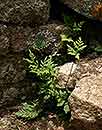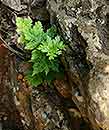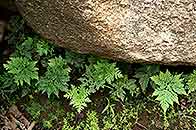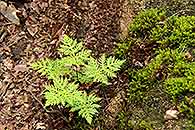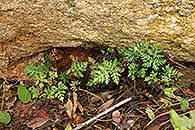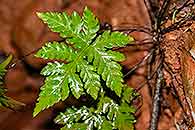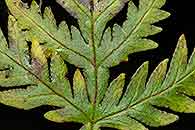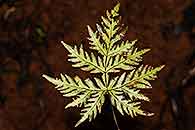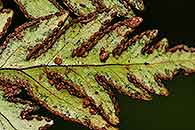Synonyms |
Doryopteris kirkii (Hook.) Alston
Doryopteris concolor (Langsd. & Fisch.) Kuhn var. kirkii (Hook.) R.E. Fr.
Doryopteris concolor (Langsd. & Fisch.) Kuhn var. nicklesii (Tardieu) Schelpe
Cheilanthes concolor (Langsd. & Fisch.) R.M. Tryon & A.F. Tryon
Pellaea geraniifolia sensu Sim
|
Common name |
|
Description |
Rhizome erect to procumbent, up to 3 mm in diameter; rhizome scales linear-lanceolate in outline, margins entire, up to 4 mm in length, dark-brown with pale margins.
Fronds sometimes weakly dimorphic, tufted, 10-40 cm tall.
Stipe up to 31 cm long, dark brown to black, grooved, shiny, basally with scattered brown scales similar to those on the rhizome.
Lamina 2 to 3-pinnatifid, basal pinnae basiscopically developed, broadly ovate to triangular in outline, up to 20 × 21 cm; pinnae margins entire to weakly lobed, hairless, dark green above, slightly paler below; venation obscure; rhachis and costae black, hairless, rhachis winged or partly unwinged.
Sori marginal, interrupted or continuous; indusium membranous, discrete or continuous, not apparent at maturity. |
Notes | Can be distinguished from other species by its glabrous lamina, that is basiscopically strongly developed and only 2- to 3-pinnatifid.
Verdcourt (2002) distinguishes var. kirkii (sori interrupted, indusium divided, rhachis winged, spores ± smooth) and var. nicklesii (sori and indusium continuous, rhachis partly unwinged, spores spinulose). |
|---|
Derivation | concolor: coloured similarly; alluding to the almost uniform shade of green of both surfaces of the frond. |
|---|
Habitat | Rock crevices, base of boulders, shaded earth banks in ravines in miombo woodland. |
|---|
Distribution worldwide | Africa, Asia, Maylasia, Polynesia, South and Central America. |
|---|
Distribution in Africa |
Angola, Botswana, Burkina Fasso, Burundi, Cameroon, Central African Republic, Dem. Republic of Congo, Eritrea, Ethiopia, Ghana, Guinea, Ivory Coast, Kenya, Liberia, Malawi, Mozambique, Namibia, Nigeria, Rwanda, South Africa, Sudan and South Sudan, Swaziland, Tanzania , Togo, Uganda, Zambia, Zimbabwe. |
Growth form |
Lithophytic, terrestrial. |
Literature |
Burrows, J.E. (1990) Southern African Ferns and Fern Allies. Frandsen, Sandton. Pages 155 - 156. (Includes a picture).
Crouch, N.R., Klopper, R.R., Burrows, J.E. & Burrows, S.M. (2011) Ferns of Southern Africa, A comprehensive guide. Struik Nature. Pages 334 - 335. (Includes a picture).
Fisher E. & Killmann D. (2008) Illustrated Field guide to the Plants of Nyungwe National Park Rwanda. University of Koblenz-Landau. Pages 90 - 91. (Includes a picture).
Jacobsen, W.B.G. (1983) The Ferns and Fern Allies of Southern Africa. Butterworths, Durban and Pretoria. Pages 244 - 245. As D. concolor var nicklesii (Tardieu) Schelpe and D. concolor var. kirkii (Hook.) R. E. Fr. (Includes a picture).
Kornas, J. (1979) Distribution and ecology of the Pteridophytes in Zambia. Polska Akademia Nauk Wydzial II Nauk Biologicznych. Pages 60 - 61. As D. concolor var nicklesii (Tardieu) Schelpe and D. concolor var. kirkii (Hook.) R. E. Fr.
Roux, J.P. (2009) Synopsis of the Lycopodiophyta and Pteridophyta of Africa, Madagascar and neighbouring islands. Strelitzia 23, South African National Biodiversity Institute, Pretoria. Page 187.
Roux, J.P. (2001) Conspectus of Southern African Pteridophyta.Southern African Botanical Diversity Network Report, 13 Pages 72 - 73.
Schelpe, E.A.C.L.E. (1970) Pteridophyta.Flora Zambesiaca, 0 Page 121. As D. concolor var nicklesii (Tardieu) Schelpe and D. concolor var. kirkii (Hook.) R. E. Fr.
Tardieu-Blot, M.-L. (1964) Ptéridophytes vol.3.Flore du Cameroun, Page 139. (Includes a picture).
Verdcourt, B. (2002) Adiantaceae.Flora of Tropical East Africa, Pages 24 - 27. Distinction is made between var. kirkii and var. nicklesii. (Includes a picture).
|
